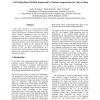Free Online Productivity Tools
i2Speak
i2Symbol
i2OCR
iTex2Img
iWeb2Print
iWeb2Shot
i2Type
iPdf2Split
iPdf2Merge
i2Bopomofo
i2Arabic
i2Style
i2Image
i2PDF
iLatex2Rtf
Sci2ools
120
click to vote
ISDA
2009
IEEE
2009
IEEE
A 3D Lifting Based Method Augmented by Motion Compensation for Video Coding
This study introduces a spatio–temporal lifting based algorithm to be used in compression of video signals. The temporal correlation of consecutive frames causes temporal redundancies, which are subject to lifting-like motion predictive compression. Similarly, neighbouring pixels are correlated within each frame. A method that uses both correlations might be 3D liftingbased decomposition. In this study, block-based motion compensation is added to the classical 3D lifting method. Domain of motion compensation is first selected as free, and then reverse-symmetric. It is observed that reverse-symmetric motion compensation improves the performance of the prediction step in 3D lifting based coding.
ISDA 2009 | Lifting Based Algorithm | Motion Compensation | Motion Predictive Compression | Operating Systems |
Related Content
| Added | 24 May 2010 |
| Updated | 24 May 2010 |
| Type | Conference |
| Year | 2009 |
| Where | ISDA |
| Authors | Sedat Telceken, Sukru Gorgulu, Ömer Nezih Gerek |
Comments (0)

